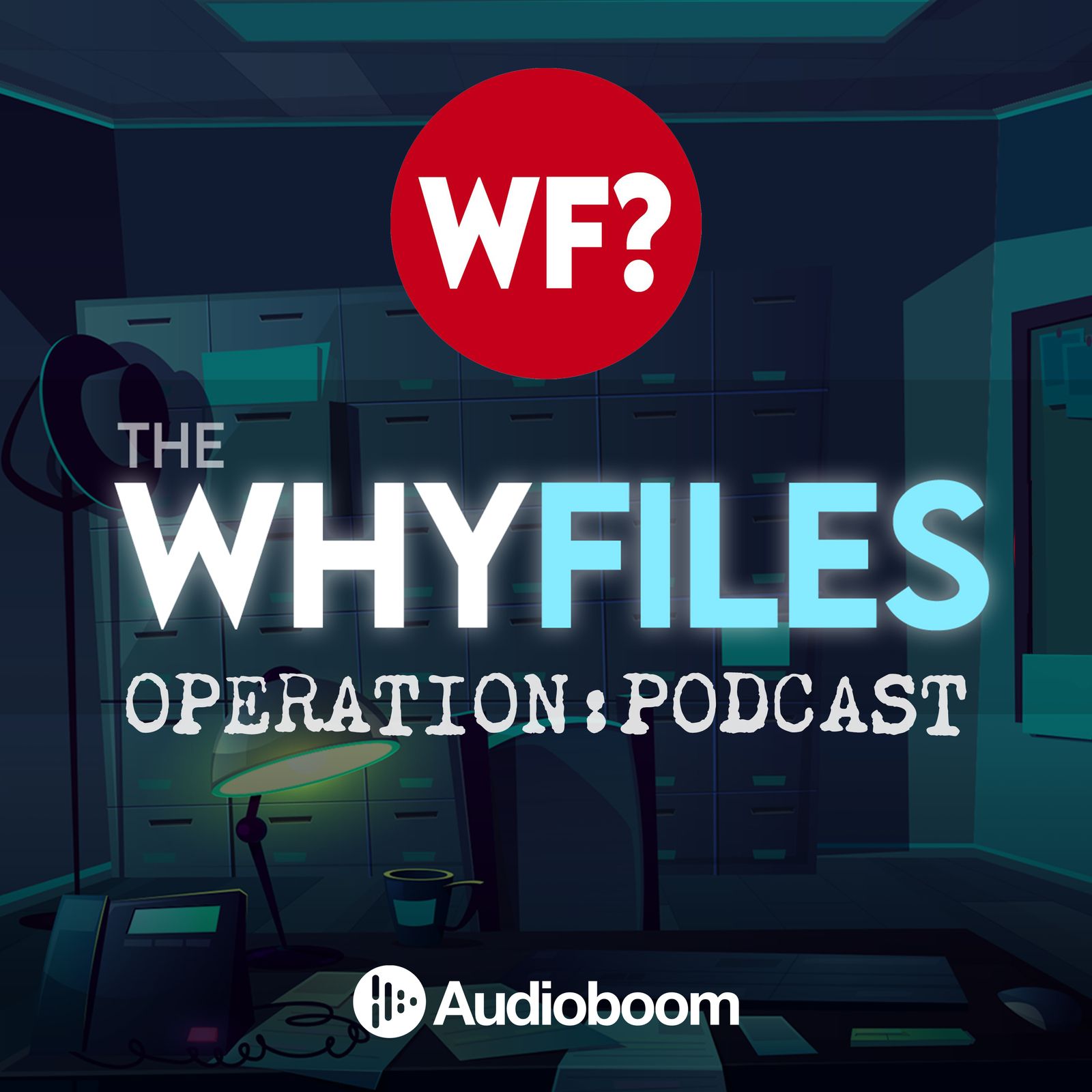
33: When will we upload our consciousness to the cloud?

The Why Files: Operation Podcast
Deep Dive
Shownotes Transcript
Plug in a Hyundai EV and the extraordinary happens.
From the charge time and range in the Ioniq 5 and 6 to the adventurous spirit of the Kona Electric to the 601 horsepower Ioniq 5N, Hyundai EVs make the extraordinary electrifying. There's joy in every journey. EPA estimated 303 mile driving range for 2024 Ioniq 5 SE SEL Limited Rear Wheel Drive and 361 mile driving range for 2024 Ioniq 6 SE Long Range Rear Wheel Drive with fully charged battery. Actual range may vary. Visit HyundaiUSA.com or call 562-314-4603 for more details.
Hey, it's your buddy AJ from the Y-Files. And Hecklefish. Right, and Hecklefish. We just wanted to tell you that if you want to start a podcast, Spotify makes it easy. It'd have to be easy for humans to understand it. Will you stop that? I'm just saying. Spotify for Podcasters lets you record and edit podcasts from your computer. I don't have a computer. Do you have a phone? Of course I have a phone. I'm not a savage. Well, with Spotify, you can record podcasts from your phone, too.
Spotify makes it easy to distribute your podcast to every platform and you can even earn money. I do need money. What do you need money for? You kidding? I'm getting killed on guppy support payments. These 3X wives are expensive. You don't want to support your kids? What are you, my wife's lawyer now? Never mind. And I don't know if you noticed, but all Y-Files episodes are video too. And there's a ton of other features, but... But we can't be here all day. Will you settle down? I need...
As long as people have been alive, they've wanted to stay alive.
And for centuries, explorers have searched for the fountain of youth. And today, scientists are hard at work researching technology that can extend the human lifespan, stop or reverse aging, and even preserve a terminally ill person indefinitely until a cure for their disease is discovered. But what if, instead of preserving our bodies,
We could preserve our consciousness by uploading it to a powerful computer. This is called mind uploading, and one startup has developed a procedure to do exactly this. It's scientifically sound. There's a waiting list to participate, and the procedure is 100% fatal. Let's find out why. There is no limit to human desire. Unfortunately, or fortunately, depending on your perspective, there is a limit to our lifespan.
But what if we could upload our memories, experiences, or entire consciousness to the cloud? This would be a sort of digital immortality, and it might not be as farfetched as you think. Famous futurist Ray Kurzweil believes we'll be able to upload our entire minds to computers by 2045. And by the end of the century, our entire bodies will be replaced by machines. Now, this might be a bit optimistic.
but it really is just a matter of time. But there are a few issues we need to solve first. The concept of uploading an entire human brain is called whole brain emulation. And there are three main areas of technology that make this possible. Scanning, processing power, and environment. Let's start with brain scanning. The complete map of the brain is called the connectome. And mapping this is the holy grail. And so far, we've only been able to map the complete connectome of one creature, the nematode.
And the nematode brain has about 300 neurons. It doesn't sound so hard. Well, the human brain has over 80 billion neurons. Oh, right. I guess a heckle fish brain has even more neurons in it. Well, and our 80 billion neurons are connected by about 100 trillion synapses. Then you have neurotransmitters, proteins, hormones and all kinds of electrochemical processes to replicate.
Now, all of this needs to be mapped and understood before we can even consider uploading. Now, our current imaging technology just isn't good enough to map this out. There are methods that are better, like cutting the brain into millions of slices and then using an electron microscope to scan all the cells and synapses. But this technique is destructive. We know that it works, though, because this was done with mice. In 2019, a cubic millimeter of a mouse brain...
A cubic millimeter of a mouse brain was successfully mapped using this technique. Now, a cubic millimeter is only the size of a grain of sand. But this piece of brain contained 100,000 neurons and over a billion synapses. But this brings us to the second problem with mind uploading processing power and storage space. When that tiny piece of mouse brain tissue was imaged,
It used about two petabytes of data storage. That's two million gigabytes. Now, OK, fine, that's doable. But for an entire human brain, we'd need two million petabytes or 2000 exabytes. That's a lot of storage. For comparison, all of Google storage, all of it is estimated to be about 15 exabytes. So human brain would need over 100 times what Google has. That's a lot.
It is. And let's say you cut a deal with Google to give you two thousand X device storage. What would they bill you for this?
Well, Google says its biggest corporate clients pay a little over $5 million per month per exabyte. So the cost to store a human brain? $10 billion per month per brain. Hey, can I borrow your Amix? Here's a little more perspective on 2,000 exabytes, also known as two zettabytes. If you had a nickel for every byte and stack them up, the pile would reach to the nearest star to the Earth, Alpha Centauri. That's far.
Whoa. 100 times. Whoa, wait, what? Yep. The stack of coins would be 2500 light years tall. I can't comprehend. I know, but you get the point. A human brain. The hecklefish brain. Is a ton of data. And that's just storage. To actually process this data would take more computing power that's available on the entire planet.
But Moore's Law states that computing power doubles every 18 months. Now, this is slowing down a little bit, but it's pretty much held true for years. So this means that even though we can't do it now, at some point in the future, we will be able to store this data and process it. And that's why MIT graduate Robert McIntyre founded Nectome, a company that claims to be able to back up your brain. And for a fee, you can put yourself on their waiting list to have your brain imaged and stored in the cloud. The only catch is...
You need to die first. No such thing as a free lunch? Nope. Brain storage is not a new concept. The Alcor Life Extension Foundation has more than 150 bodies and severed heads stored in liquid nitrogen. But there's some dispute as to whether liquid nitrogen damages brain tissue. So a few years ago, Robert McIntyre, while working with a cryobiologist, came up with a different approach. Their technique combines typical cryonics with embalming to preserve the brain structure.
Nectome developed aldehyde-stabilized cryopreservation, or ASC. And Nectome says their technology can preserve a detailed brain ultra structure over long time scales. We're talking hundreds or even thousands of years. And their technique has proved effective at preserving an entire brain at nanometer level, including the entire connectome. So all cells, synapses, fibers, proteins, molecules
All of it. And there's no expectation of reviving the preserved tissue like with Alcor Life's cryonics. Instead, the idea is to retrieve the information that's stored on the brain anatomy. Ken Hayworth, a neuroscientist and president of the Brain Preservation Foundation, said if the brain is dead, it's like the computer is off. But that doesn't mean the information isn't there.
That's really interesting. Will you sign up for it? Well, if you put down a $10,000 deposit, you can get on the waiting list. But there's a bit of a catch. You need to still be alive at the beginning of the procedure. And at the end of the procedure, you won't be. And that's okay. Your body's gone, but your consciousness lives on. But when you wake up, what's that like?
Uploading your mind gives you functional immortality. It means that you continue to exist until your mind's digital copy is deleted or destroyed. You better hope your brain doesn't run on Windows 10. Well, that's a pretty good point.
What happens if your digital mind becomes corrupted, hacked or infected with malware? That experience might leave you with feelings of pain, paranoia and psychosis that could last forever. But let's assume everything goes according to plan. What does your digital consciousness do? Where does it go? Well, one option is to have yourself downloaded into a physical body. And that could be organic or cybernetic, but probably would be something completely mechanical. You become a robot.
Well, sort of. A robot is defined as a mechanism designed with human-like features or to mimic human behavior. You would be more than that. You would be a conscious sentient being inhabiting a mechanical form. Now, assuming the technology is there,
You would be able to taste ice cream, smell flowers, have sex, fall in love, all like humans do. But you'd be able to do these things forever. Another option for your digital afterlife is to inhabit a simulation. By inserting your consciousness into an elaborate program, you'd be able to create and live in any type of world you can imagine. Kind of like a god.
You'd be able to walk with dinosaurs or visit other planets. You could explore outer reaches of the galaxy or investigate molecules in inner space. By adjusting your programming, you could delete painful memories and relive positive experiences in an infinite number of ways. You could create a perfect utopia. And if you don't like something in your simulation, change it. And after hundreds, thousands or even millions of years, you may have seen and experienced everything you could possibly imagine.
And at that time, you might choose to finally rest and turn off your program altogether. But would you? When we get to the point where our minds could be converted into a conscious, sentient program, we'll have security in knowing that if we become injured or ill, that we can continue to exist in digital form. But would we still be human?
I don't know. That's a question for philosophers. But I do know that because our time here is so short, that creates urgency, urgency to experience all we can while we can. That's why there's the concept of a bucket list. The urgency makes us human. If we could live forever and experience literally everything, what happens after that? What purpose would we serve and what's our reason for even existing? And after a while, would we even want to?
Now, digital immortality isn't happening anytime soon, so go out and enjoy actual life while you can. And a simulation without risk will never be as exciting or as fun as the real thing anyway. We just have to accept that we're not meant to live forever, and that's okay. But it'd be nice to have the option.
Thank you so much for hanging out with me today. My name is AJ. That's Hecklefish. This has been the Y-Files. If you had fun or learned anything, do me a favor and like, subscribe, comment, and share. The YouTube algorithm is like an evil sentient digital consciousness bent on our destruction, but with your help, we can defeat it. Until next time, be safe, be kind, and know that you are appreciated.